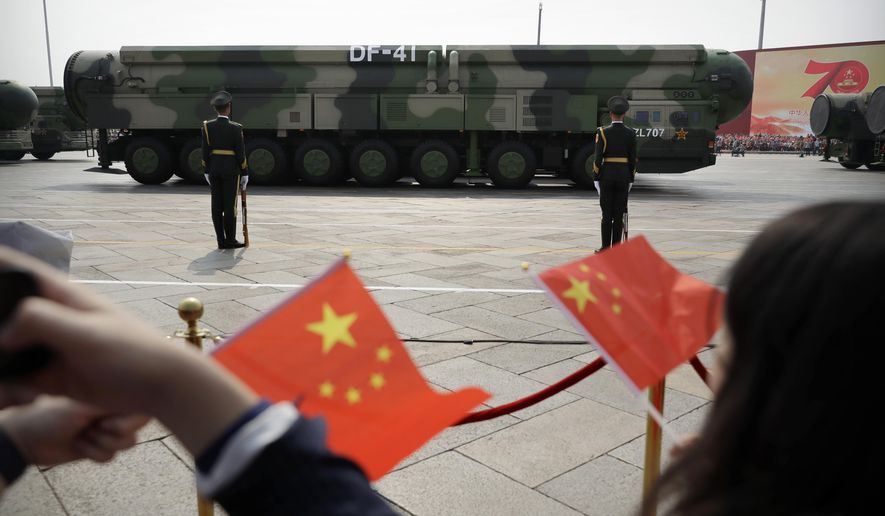A version of this story appeared in the daily Threat Status newsletter from The Washington Times. Click here to receive Threat Status delivered directly to your inbox each weekday.
China is showing no signs of slowing the furious pace of its program to develop nuclear weapons delivery systems, a sign that Beijing is shifting away from a strategy of minimum deterrence, the commander of the U.S. Strategic Command told Congress on Thursday.
Air Force Gen. Anthony J. Cotton told the Senate Armed Services Committee that the speed of China’s nuclear force buildup in recent years is a major worry that keeps him awake at night.
“For me, it’s [China’s] capacity, capability to build out their weapons systems, their arsenal,” Gen. Cotton said. “It’s that simple.”
Chinese military leaders are speeding up the deployment of nuclear forces, including sharp increases in land-based missiles, missile-firing submarines and a new bomber capable of launching a nuclear-tipped ballistic missile, he said.
The commander warned in his prepared testimony that nuclear war dangers are increasing because of strategic cooperation between China and other U.S. adversaries, notably Russia, North Korea and Iran. Chinese and Russian nuclear bombers recently conducted joint patrols, an indication that the two authoritarian allies are prepared to combine their nuclear power, he said.
Air Force Gen. Stephen N. Whiting, commander of the Space Command, told the Senate panel that China’s space weaponry poses a strategic threat to American satellites, both military and civilian, that are used for various vital functions.
China’s military “clinically studied” U.S. space systems with an eye to finding vulnerabilities that could be attacked in a crisis or conflict, Gen. Whiting said.
“And now [Beijing] is rapidly building systems to hold that architecture at risk,” Gen. Whiting said.
Sen. Tom Cotton, Arkansas Republican, disclosed during the hearing that the Chinese nuclear arsenal has expanded by more than 100% since Chinese President Xi Jinping took power in 2012 and that the Pentagon estimates the expansion will increase by 500% before it is through. China’s communist regime, until very recently, maintained a much smaller nuclear arsenal compared with those of Russia and the United States, contending it needed only enough missiles to deter a nuclear strike by a hostile power.
“The breakout that we saw, and the advancement and how quickly the advancements we are seeing on China to create a viable triad are breathtaking,” said Gen. Cotton, noting that the rapid fielding of weapons is “unprecedented.”
China’s land-, air- and sea-based nuclear array includes H-6 bombers, a new H-20 stealth bomber and six missile submarines with advanced JL-3 missiles “capable of striking the continental United States from littoral waters,” he said.
Strategic Command officials reported to Congress a year ago that China’s arsenal of land-based strategic intercontinental ballistic missile (ICBM) launchers exceeded the number of U.S. Minuteman III launchers.
“Today, the PRC likely has more than 500 operational nuclear warheads and, should it continue building weapons at its current pace, could have more than 1,000 nuclear warheads by 2030,” Gen. Cotton said in his statement.
Three large ICBM fields were built in 2022, with at least 300 solid-fuel DF-31A missiles armed with multiple warheads.
China is building a new generation of road-mobile ICBMs and has 1,000 medium-range missiles that can be armed with either conventional or nuclear warheads that have the range to threaten the U.S. island of Guam and allied nations in the region.
“These developments, combined with [China’s] increasing counter-space and cyber capabilities, pose a complex but not insurmountable challenge to U.S. strategic deterrence,” Gen. Cotton said.
Beyond ‘minimum’
Gen. Cotton testified that China’s large nuclear buildup, contrary to what its leaders say, no longer ranks as a “minimum deterrent” force. China also appears to have abandoned a decade-old strategy of concealing its military capabilities as it grows into an economic superpower rivaling the U.S.
Now “they’re showing us their capabilities and showing us how fast they can grow,” Gen. Cotton said.
Gen. Cotton said the growing ties among China, Iran, Russia and North Korea create the possibility that U.S. commanders will be faced with the challenge of simultaneous crises and increased aggression on multiple fronts. Chinese and Russian bombers flew joint patrols in the western Pacific in November and a joint maritime patrol near the Aleutian Islands over the summer.
North Korea and Iran are delivering arms to Russia for its war in Ukraine, helping Moscow reclaim the initiative on the battlefield over outgunned Ukrainian forces.
“This increasing cooperation and the risk of simultaneous crisis or conflict place a premium on credible, robust and flexible joint force response options that signal our readiness and commitment to potential adversaries, allies and partners,” Gen. Cotton said.
The four-star general urged senators to support the modernization of aging U.S. nuclear forces that are being upgraded with new missiles, bombers and submarines.
Gen. Cotton said America’s strategic forces are more powerful and remain fully capable of deterring potential adversaries despite nuclear advances by China and Russia.
“Today, we’re still superior. No adversary should ever doubt our capability today,” Gen Cotton said, even while acknowledging that current threats are “unlike anything America has encountered.”
Sen. Roger F. Wicker of Mississippi, a former chairman and now the ranking Republican on the Armed Services Committee, noted that a congressional strategic commission last year called for rapidly updating nuclear and space programs to counter the threats from China and Russia. He said the Biden administration has failed to heed the call.
“Unfortunately, the current administration has naively maintained the status quo,” he said. “While the United States has stayed complacent, Russia and China have advanced by leaps and bounds in their nuclear and space programs.”
• Bill Gertz can be reached at bgertz@washingtontimes.com.




Please read our comment policy before commenting.